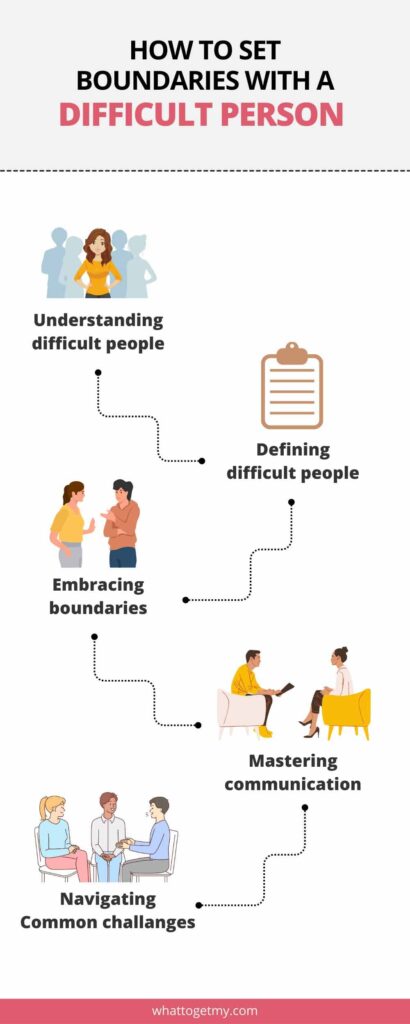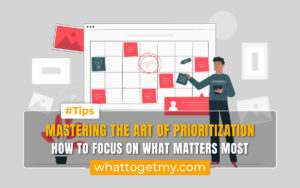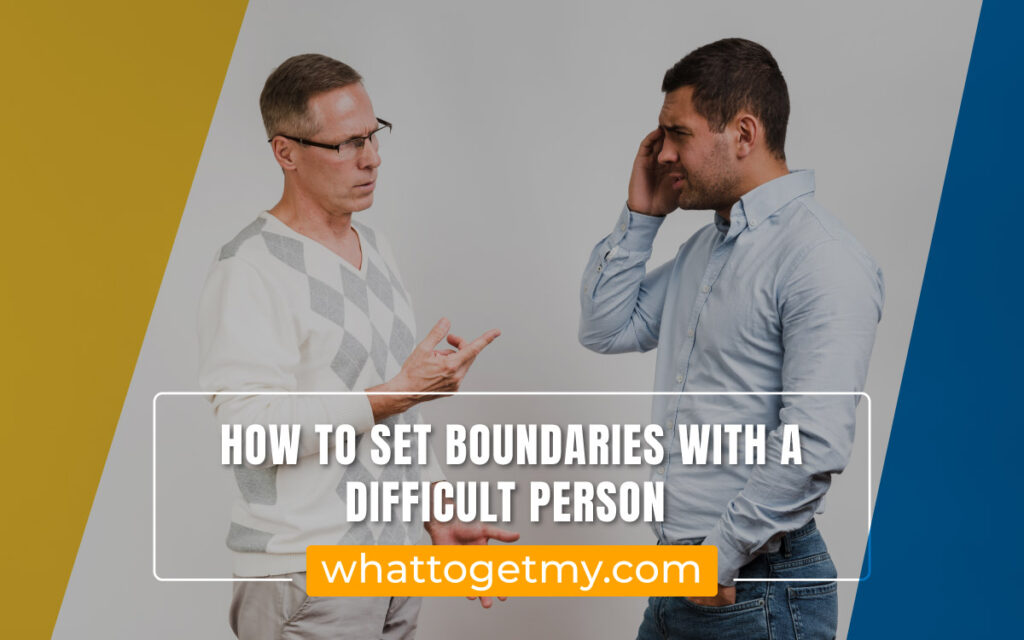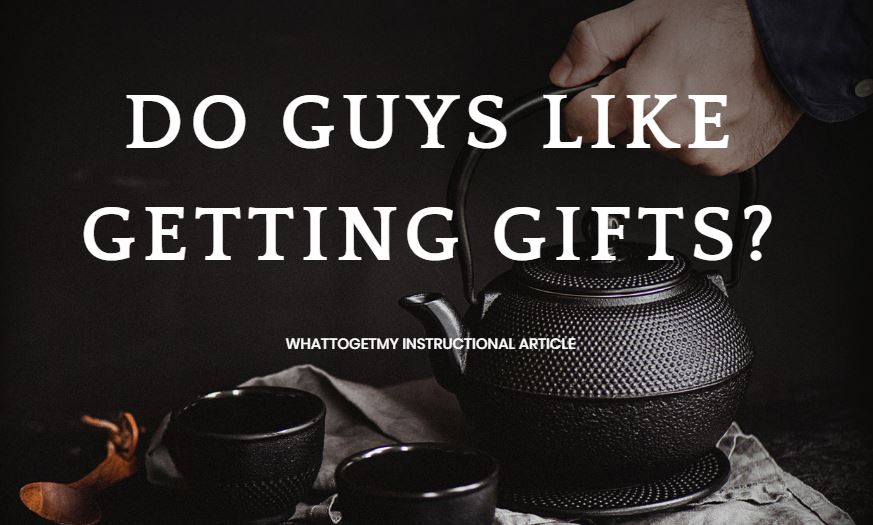5 Expert Tips To Tame That Annoying Pal: How to Set Boundaries With A Difficult Person (2023).
Dealing with difficult people can be emotionally draining and challenging, often leaving us frustrated and overwhelmed.
And who could forget the whimsical negativity gurus? They sprinkle a dash of skepticism and grumbling in every interaction.
Boundaries serve as our graceful partners in the intricate dance of human interactions, guiding us in setting limits with challenging individuals.
Imagine embarking on a voyage without a map or compass—an aimless expedition lacking direction and purpose.
In the intricate tapestry of boundary setting, self-awareness is our guiding star, illuminating our limits and values.
Dealing with difficult people can be emotionally draining and challenging, often leaving us frustrated and overwhelmed. This guide will explore practical strategies and techniques on how to set boundaries with difficult people. You can regain control, establish healthy limits, and create a more balanced and harmonious dynamic.
1. Understanding Difficult People: Unraveling the Quirks and Nuances That Make Interactions Challenging
Defining difficult people: We delve into the characteristics and behaviors that make someone challenging to interact with, including aggression, manipulation, and negativity.
Navigating interactions with difficult people can sometimes feel like cracking a mysterious code. But fear not! In this delightful article, we will dive into the quirks and behaviors that define these fascinating characters, shedding light on what makes them tick and providing you with handy insights to handle these challenging relationships better, including creating healthy boundaries with challenging individuals.
Defining Difficult People
Ah, demanding people who add a touch of excitement to our lives! Let’s start by uncovering some of their intriguing traits. First, we have the lively bunch known for their aggression. They bring energy to any conversation with their passionate, assertive nature!
Next, we have the masterful manipulators. These mischievous souls possess an uncanny talent for turning situations into thrilling puzzles. Their charm and persuasiveness make you wonder if you’re starring in your mystery novel. But don’t worry; we’ll equip you with the tools to solve those mind-bending riddles!
And who could forget the whimsical negativity gurus? They sprinkle a dash of skepticism and grumbling in every interaction. With their knack for spotting flaws and unique ability to find clouds on the sunniest days, they truly bring a touch of quirkiness to any gathering. But fear not; we’ll help you find the silver linings in their amusingly gloomy world!
Remember, difficult people are as diverse as a vibrant bouquet of personalities, and they may possess a medley of these charming traits or even surprise you with a few unexpected ones. Embrace the adventure of understanding and engaging with them, armed with strategies to navigate their intriguing quirks and create more harmonious relationships.

Embracing Boundaries: Unlocking the Power of Setting Limits with Difficult People
The importance of boundaries: Go down this rabbit hole in understanding why establishing boundaries with difficult people is crucial, highlighting their positive impact on our emotional well-being and relationships.
Boundaries serve as our graceful partners in the intricate dance of human interactions, guiding us in setting limits with challenging individuals. In this enlightening article, we will embark on a journey to discover the profound significance of setting boundaries. Brace yourself for a transformative exploration, where we unravel the positive impact boundaries can have on our emotional well-being and relationships.
The Importance of Boundaries
Picture a world without boundaries—a chaotic realm where our emotional well-being and relationships are left vulnerable to the whims of difficult people. Thankfully, setting boundaries acts as our trusty compass, providing clarity and protection.
When we establish boundaries for dealing with difficult people, we safeguard our emotional well-being. Boundaries allow us to preserve our mental and emotional energy by limiting what we are willing to tolerate. They empower us to prioritize self-care and maintain a healthy life balance. By clearly defining what is acceptable and what is not, we shield ourselves from toxic behavior’s negative impacts, helping preserve our inner peace and serenity.
But the influence of boundaries extends beyond our well-being; they also play a pivotal role in shaping our relationships. By setting boundaries, we establish a framework for healthy and respectful interactions. Boundaries communicate our needs and expectations, fostering clear communication and promoting mutual respect. They help establish a harmonious balance between assertiveness and empathy, enabling us to navigate difficult conversations gracefully and with understanding.
In the realm of difficult people, boundaries become our guiding light. They give us the tools to assert our needs, protect our emotional landscapes, and cultivate relationships grounded in respect and understanding. So, embrace the power of boundaries, especially difficult person boundaries, and embark on a transformative journey towards greater emotional well-being and healthier relationships.
People not picking up after their pets were considered the most annoying, according to this survey (shown above) on Statista.
Embrace Your Inner Navigator: Unveiling Self-Awareness in Setting Personal Boundaries
Recognizing your boundaries: Exploring self-awareness and understanding your limits and values that guide your boundary-setting process.
In the intricate tapestry of boundary setting, self-awareness is our guiding star, illuminating our limits and values. Join us on a captivating journey of self-discovery as we delve into recognizing your boundaries. Through this exploration, we will uncover the profound impact of self-awareness in guiding your boundary-setting process and empowering you to create healthier and more fulfilling relationships.
Recognizing Your Boundaries
Imagine embarking on a voyage without a map or compass—an aimless expedition lacking direction and purpose. Similarly, navigating boundaries without self-awareness can leave us adrift and unsure. Recognizing your boundaries begins with cultivating a deep sense of self-awareness.
Self-awareness invites you to explore your inner landscape, uncovering your limits and values. It involves reflecting on your emotions, thoughts, and experiences to clarify what truly matters to you. By understanding your triggers, desires, and values, you can establish a solid foundation for setting boundaries that align with your authentic self.
Self-awareness empowers you to identify the limits that define your comfort zone. These limits can vary from person to person and encompass different aspects of life, including emotional, physical, and social boundaries. Self-reflection allows you to recognize when your boundaries have been crossed and to discern between discomfort and violation.
Furthermore, self-awareness helps you define your values, which act as guiding principles in setting boundaries. Your values represent what you hold dear and believe is essential in life. They serve as a compass, directing you toward relationships and situations that align with your authentic self and steering you away from those that do not.
By nurturing self-awareness, you become an empowered navigator with the tools to recognize and define your boundaries and the knowledge of how to navigate boundaries with a difficult person. Through this process of self-discovery, you gain the clarity and confidence needed to set boundaries that honor your authentic self, leading to greater self-respect, healthier relationships, and a more balanced and fulfilling life.
2. Navigating Tricky Waters: Mastering Communication, Boundaries, and Self-Care with Difficult People
Welcome, fellow adventurers, as we navigate strategies for setting boundaries with challenging individuals.
Prepare yourself with essential tools to navigate these encounters with grace and positivity. In this engaging article, we’ll explore effective communication techniques, defining personal limits, and the importance of self-care. So, let’s dive in and discover how we can skillfully handle difficult individuals while staying true to ourselves.
a) Communication and Assertiveness Techniques
Clear and direct communication is our trusty compass when dealing with difficult individuals. Explore the marvelous world of effective communication, where we learn to express our boundaries straightforwardly and assertively. Using “I” statements, we can confidently communicate our needs and expectations without blaming or accusations. Additionally, delve into the power of active listening, a valuable skill that fosters understanding and enhances healthier communication. With these techniques, we can navigate the complexities of communication and foster better connections with challenging individuals.
b) Defining and Enforcing Personal Boundaries
It’s time to map out our boundaries and establish firm limits with those challenging characters. Through self-reflection exercises, we gain clarity on our values and boundaries, allowing us to set clear expectations for ourselves and others. Practical tips and real-life examples will guide us in establishing explicit boundaries with difficult people, ensuring our limits are understood and respected. Enforcing consequences when boundaries are violated becomes vital for maintaining their effectiveness and our well-being. Holding ourselves and others accountable creates a healthier environment and cultivates more robust relationships.
c) Emotional Regulation and Self-Care
As we navigate the turbulent waters of maintaining boundaries with hard-to-handle people, it’s crucial to master emotional regulation and prioritize self-care. By managing our emotional reactions, we can maintain a sense of calm and composure in challenging situations. Discover strategies like deep breathing exercises and mindfulness techniques to anchor yourself amidst stormy encounters. Moreover, embracing self-care becomes our life jacket, helping us nurture resilience and preserve our emotional well-being. By engaging in activities that bring us joy and prioritizing self-care, we can stay afloat and navigate the seas of difficulty with strength and grace.
3. Navigating Common Challenges and Pitfalls: Overcoming Resistance, Embracing Assertiveness, and Seeking Support
Embark on a journey to navigate the twists and turns of setting boundaries with difficult people as we delve into the common challenges and pitfalls that may arise along the way. This section will equip you with tips for setting boundaries with a difficult person, including strategies to overcome resistance, maintain assertiveness in the face of conflict, and seek support when the going gets tough. With these tools in your arsenal, you’ll navigate the bumpy terrain of boundary-setting with confidence and grace.
a) Resistance and Pushback
Setting boundaries can sometimes be met with resistance from difficult individuals. Fear not, for we shall arm you with strategies to overcome these challenges! We’ll explore the various forms of resistance and manipulation that may arise when managing boundaries with troublesome individuals, such as attempts to test or disregard your boundaries. By anticipating these tactics, you can respond clearly and assertively, ensuring your boundaries are respected. We’ll guide you in developing effective communication techniques to navigate these encounters, enabling you to stand firm in your boundaries while maintaining healthy relationships.
b) Assertiveness in the Face of Conflict
In the realm of boundary-setting, conflicts may occasionally arise. But fear not, brave soul! We’ll provide the tools to maintain assertiveness and handle conflict constructively. Learn to confidently express your needs and expectations, even in opposition or disagreement. We’ll explore techniques to stay calm and composed during conflicts, allowing you to respond constructively and respectfully. By staying true to your boundaries and asserting yourself thoughtfully, you can navigate conflicts with difficult individuals while preserving the integrity of your relationships.
c) Seeking Support
When the waters become particularly turbulent, seeking support can be a lifesaver. Recognize the value of reaching out to trusted friends, family members, or professionals who can provide guidance and lend an empathetic ear. We’ll explore the benefits of seeking support in navigating the challenges of dealing with difficult people. Whether venting your frustrations, seeking advice, or gaining fresh perspectives, a support network can offer valuable insights and emotional support. Remember, you don’t have to face these challenges alone. By surrounding yourself with a supportive community, you can find solace and strength as you navigate the sometimes treacherous waters of boundary-setting.
As you venture through the terrain of setting boundaries with difficult people, remember that challenges may arise but can be overcome. By addressing resistance, embracing assertiveness, and seeking support, you’ll navigate these common pitfalls with resilience and grace. Stand firm in your boundaries, engage in constructive communication, and reach out for support when needed. With these tools, you’ll confidently navigate the labyrinth of difficult relationships and emerge stronger on the other side. Happy navigating!
4. Nurturing Boundaries and Embracing Self-Growth: The Art of Regular Evaluation and Personal Reflection
Welcome to the realm of boundary maintenance and self-growth! In this enlightening article, we’ll explore the importance of continuously evaluating and adjusting boundaries as we navigate the ever-changing landscape of relationships. Through the power of self-reflection and personal growth, we’ll uncover the secrets to increased self-awareness and resilience. Prepare to embark on a journey of nurturing boundaries while nurturing your growth and development.
a) Regular Evaluation and Adjustment
Boundaries are not set in stone; they require regular evaluation and adjustment. We’ll guide you on the art of ongoing assessment as situations and relationships evolve. By periodically reflecting on your boundaries, you can ensure they align with your values, needs, and personal growth. We’ll explore practical strategies for assessing the effectiveness of your boundaries and making necessary adjustments. Remember, boundaries are dynamic and adaptable, like the ever-changing tides. Embrace evaluating and refining your boundaries, empowering yourself to create healthier relationships and environments.
b) Self-Reflection and Growth
The path to nurturing boundaries is intimately intertwined with self-reflection and personal growth. By engaging in self-reflection, you embark on a journey of increased self-awareness and resilience. We’ll encourage you to delve into the depths of your thoughts and emotions, exploring how your boundaries align with your values and desires. Through this process, you’ll gain clarity on your needs and establish boundaries honoring your authentic self. Embrace personal growth as an opportunity to expand your understanding, challenge limiting beliefs, and develop stronger boundaries. By nurturing your growth, you cultivate the strength and wisdom to navigate difficult relationships and foster healthier connections.
Remember the importance of regular evaluation and adjustment as you nurture your boundaries. Embrace self-reflection and personal growth as catalysts for increased self-awareness and resilience. Maintaining boundaries and fostering growth will create a foundation for healthier relationships and a more fulfilling life. Enjoy the journey of continuous self-discovery and growth as you navigate the beautiful balance of nurturing boundaries and nurturing yourself.
Frequently Asked Questions:
1. Q: How do I know if I need to set boundaries with a difficult person?
A: It’s important to recognize signs of discomfort, such as feeling drained, stressed, or manipulated in the presence of a person. If you find yourself consistently experiencing negative emotions or compromising your well-being, it may be time to set boundaries.
2. Q: How do I communicate my boundaries to a difficult person without causing conflict?
A: When communicating boundaries, it’s crucial to use strong and respectful language. Clearly express your needs and expectations using “I” statements, focusing on your feelings and experiences rather than attacking or blaming the other person. Maintaining a calm and open demeanor increases the chances of having a constructive conversation.
3. Q: What if the difficult person ignores or disregards my boundaries?
A: It can be challenging when someone doesn’t respect your boundaries. In such situations, you must reinforce your boundaries and consider implementing consequences. Firmly and consistently communicate the importance of your boundaries and be prepared to enforce them. Seeking support from trusted friends, family, or professionals can also provide guidance and assistance in dealing with this challenge.
Remember, setting boundaries with difficult people is an ongoing process that requires patience and self-care. Each situation is unique, and it’s essential to trust your instincts and prioritize your well-being throughout the journey.
Conclusion:
In conclusion, setting boundaries with difficult people is an empowering journey that encompasses self-awareness, assertiveness, and consistent self-care. By implementing the strategies discussed in this article and remaining committed to your well-being, you can create healthier and more fulfilling relationships while safeguarding your mental and emotional health.
Throughout this journey, it is essential to cultivate self-awareness, understanding your needs, values, and limits. Armed with this knowledge, you can confidently define and assert your boundaries. Assertiveness plays a crucial role, allowing you to communicate your boundaries effectively, using “I” statements, and maintaining respectful dialogue. Additionally, maintaining consistent self-care serves as your guiding compass, ensuring that you prioritize your well-being and protect your mental and emotional health. Practicing self-compassion, self-reflection, and seeking support when needed are all vital aspects of this ongoing process.
Remember, setting boundaries with difficult people is an act of self-empowerment. By embarking on this transformative journey, you gain personal growth, deepen your understanding of your boundaries, and develop the necessary skills to effectively communicate and assert your boundaries. As a result, you will cultivate healthier relationships built on mutual respect and understanding. Embrace the power within you, trust in your ability to set boundaries, and create a life where your well-being thrives.
01 HOURS 24 MINUTES
ESTIMATED TIME DESIGNING AND UPLOADING THIS ARTICLE
08 HOURS 26 MINUTES
ESTIMATED TIME RESEARCHING AND WRITING THIS ARTICLE
LOOKING FOR MORE GIFTS?
Try our AMAZING GIFT FINDER TOOL! Find GIFTS with 1 CLICK!
LOOKING FOR MORE GIFTS?
Try our AMAZING GIFT FINDER TOOL! Find GIFTS with 1 CLICK!
LOOKING FOR MORE GIFTS?
Try our AMAZING GIFT FINDER TOOL! Find GIFTS with 1 CLICK!
You Might Also Like

15 Astronaut Toys for Pre-Schoolers
Are you looking for fun astronaut toys for your child? Do you have curious preschoolers that are eager to learn about space and galaxies? Do you want to improve their knowledge about the universe? If your answer is yes, we can help. We have made

5 Things to Say to an Ex Boyfriend You Still Love
5 Things to Say to an Ex Boyfriend You Still Love. WhatToGetMy Instructional Article While it is always tempting to want to go back to an ex-lover, it is not always advisable to do so, especially where the break-up was as a result of legitimate

How Many Gifts Should a Child Get for a Birthday
How Many Gifts Should a Child Get for a Birthday WhatToGetMy Instructional Article Looking into the pile of gifts prepared for your child’s birthday gets you thinking: Is this over-excessive? Should you have stopped, like, ten gifts ago? Are there any rules you should follow

Popular Gifts for 80 Year Old Man
Your grandpa’s birthday is approaching and you want to show your love for him through a gift. The problem is you don’t know what would an elderly man want for his birthday! That’s why we are here. We researched and found some amazing products that

Does healthy hair dry slow or fast? 6 explanations.
Does healthy hair dry slow or fast? 6 explanations. WhatToGetMy Instructional Article How quickly your hair dries depends on several factors. Slow or fast-drying hair is not a definitive test for hair health. Keep reading to find out if healthy hair dry slow or fast.
Fun-Filled Memorial Day Weekend in San Diego: Your 2025 Adventure Guide
Fun-Filled Memorial Day Weekend in San Diego: Your 2025 Adventure Guide So, you’re thinking of hitting the San Diego beaches this summer? Smart move, kid! The water’s finally warm enough that your toes won’t turn into popsicles when you dip them in. Pack your sunscreen (trust me, that “natural tan” you’re hoping for is just

27 Places to Go for Your 18th Birthday
27 Places to Go for Your 18th Birthday WhatToGetMy Instructional Article Well now, look who just became 18, look who just became an adult. First of all, congratulations on reaching this milestone. You have just reached the age of freedom and responsibility and the keys

Gifts for Amateur Photographers they secretly want from you
Gifts for amateur photography should be practical and useful to their craft. Unlike other hobbies, amateur photography morphs from a fun thing to do to a quest for excellence. If you are looking to surprise an amateur photographer in your life, you’ll need to put

Mastering the Art of Prioritization: Focus on What Matters Most
5 Tips To Mastering the Art of Prioritization: How To Focus on What Matters Most in 2023 In the world of instant coffee and constant deadlines, it often feels like there needs to be more time to accomplish everything on our to-do lists. Prioritization determines

Have you ever been protected or vouched by your boss from something you did for the company? How about a coworker covering up your schedule or activity because you have to attend an emergency? Then you must have had that grateful feeling towards them. If



